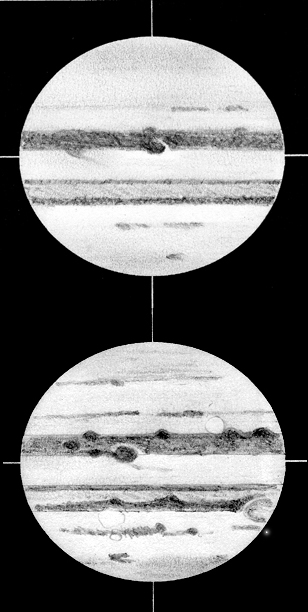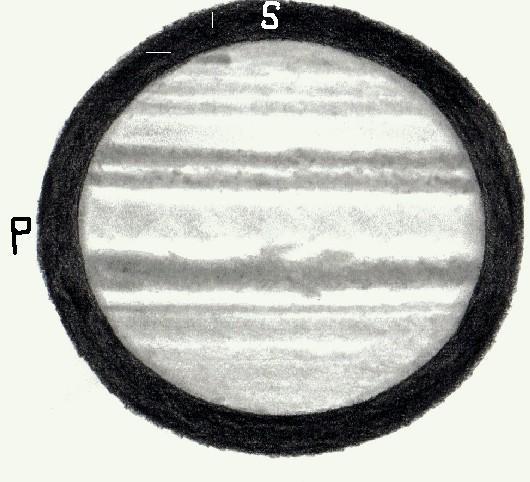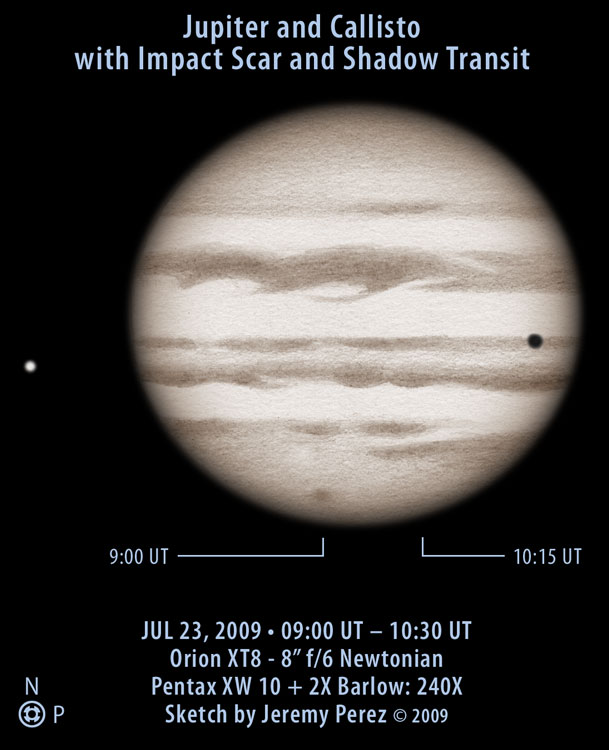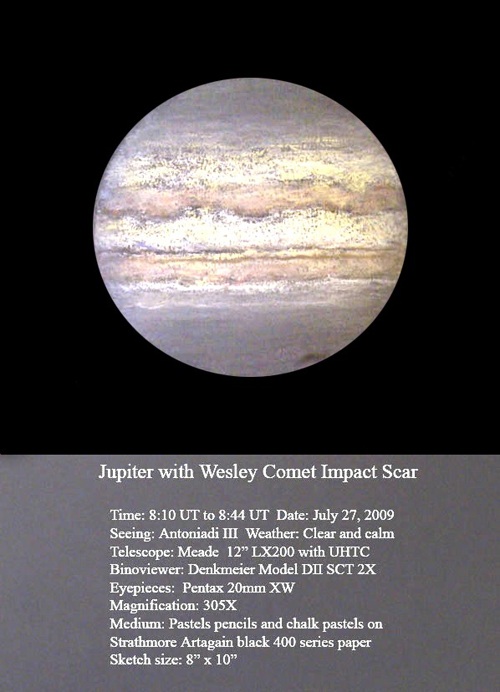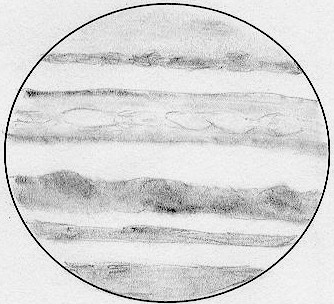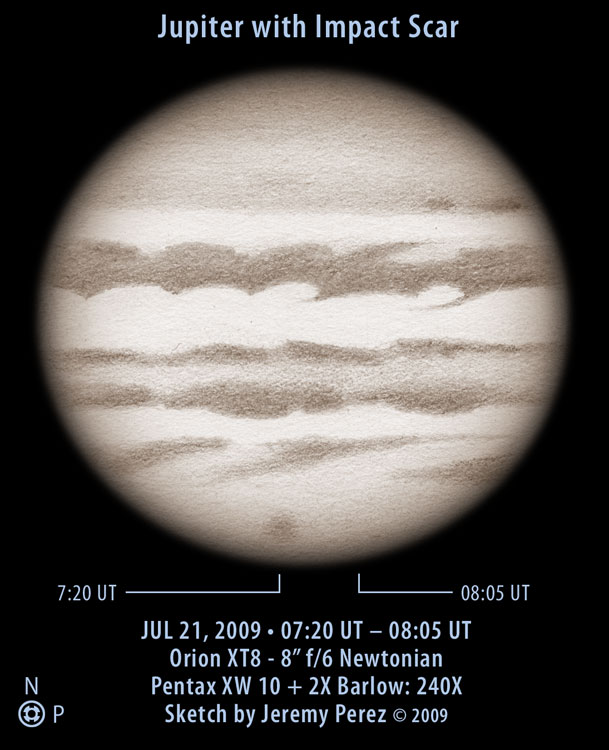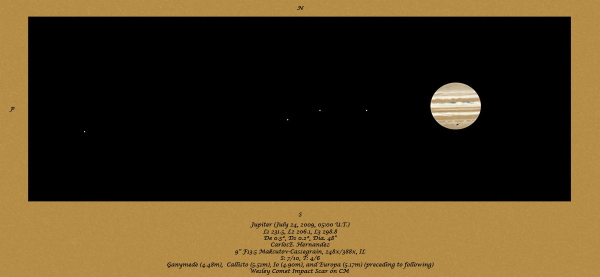
Jupiter and the Wesley Comet Impact Scar
Sketch and Details by Carlos E. Hernandez
I made an observation of Jupiter showing the Wesley Comet Impact Scar (WCIS) over the South Polar Region (SPR) of Jupiter. The impact scar appeared bi-lobed with extensions and a tail.
Date (U.T.): July 24, 2009
Time (U.T.): 05:00
L1 231.5, L2 206.1, L3 298.8
Ds 0.5, De 0.2, Diameter 48″ (Equatorial)
Instrument: 9-inch (23-cm) F/13.5 Maksutov-Cassegrain
Magnification: 248x and 388x
Filters: None
Seeing (1-10): 7, Antoniadi (I-V): II
Transparency (1-6): 4
Notes:
North Polar Region (NPR): Appears dark to dusky (3-4/10) and mottled. No other detail is visible within.
North Temperate Zone (NTZ): Appears shaded to bright (6-7/10) without any detail visible within it.
North Temperate Belt (NTB): Appears to be divided into two thin, dusky (4/10) components (North and South) with a bright (7/10) middle zone. A dark (3/10) elongated condensation is noted along the northern border of the northern component towards the preceding limb.
North Tropical Zone (NTrZ): Appears bright (7/10) without any detail visible within.
North Equatorial Belt (NEB): Appears dark to shaded (3-4/10) with dark condensations (3/10) and bright rifts (7/10) noted within it. Dark (3/10) barges (rods) are noted along the northern border (NRB-N) and blue festoons along the southern border (NEB-S).
Equatorial Zone (EZ): Appears bright (7/10) with a thin, dull (5/10) band over the middle portion (equator). Very bright (8/10) ovals are noted over it’s northern half along the North Equatorial Belt (NEB).
South Equatorial Belt (SEB): Appears dark to dusky (3-4/10) with the southern component (SEB-S) thicker than the northern component (SEB-N). The South Equatorial Belt Zone (SEBZ) appears a pastel orange color with thin, dull (5/10) columns extending between the northern and southern components.
South Tropical Zone (STrZ): Appears bright (7/10) with a thin, angled dusky (4/10) projection over it’s preceding half extending from the northern border of the South Temperate Belt (STB-N).
South Temperate Belt (STB): Appears dark to dusky (3-4/10) with a thin, shaded (6/10) section (zone?) over it’s southern half which contains four bright (7/10) ovals within it’s southern portion.
South Polar Region (SPR): Appears dark to dusky (3-4/10) and mottled. The Wesley Comet impact Scar (WCIS) noted along the central meridian (CM). The WCIS appears very to extremely dark (8-9/10), bi-lobed (smaller southern component than northern), with dusky to dull (4-5/10) projections (“wings”), and thin, dusky (4/10) projection (“tail”) to the north. The WCIS reminds me of the impact scars produced by Shoemaker-Levy 9 in 1994.
The Galilean satellites visible are (preceding to following) Ganymede (4.48m), Callisto (5.51m), Io (4.90m), and Europa (5.17m).
I made a sectional sketch of the Wesley Impact Scar (WCIS). The impact scar appeared as described above (bi-lobed, projections (“wings and a tail”). The preceding end of the impact scar was timed at 05:00 U.T. (L2 206.1/L3 298.9), center (05:09 U.T., L2 211.6/L3 304.3), and following end (05:22 U.T., L2 219.4/L3 312.1).
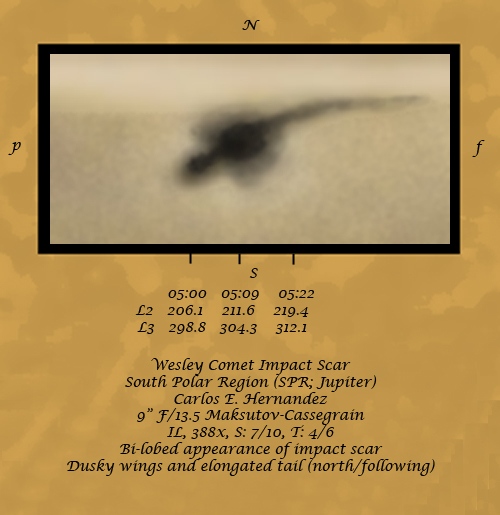
Sectional view of Jupiter and the Wesley Comet Impact Scar
Sketch and Details by Carlos E. Hernandez
The best of luck in your own observations/imaging of Jupiter and the Wesley Comet Impact Scar (WCIS).
Digital images produced in Photoshop CS3.
Carlos
